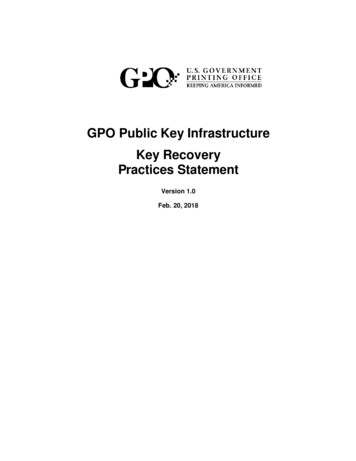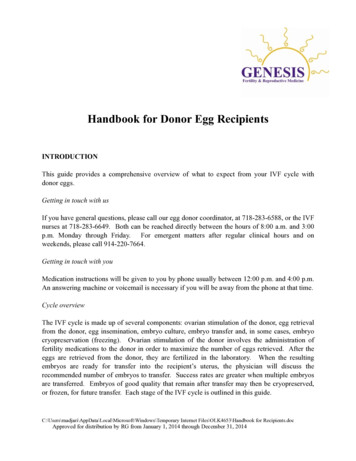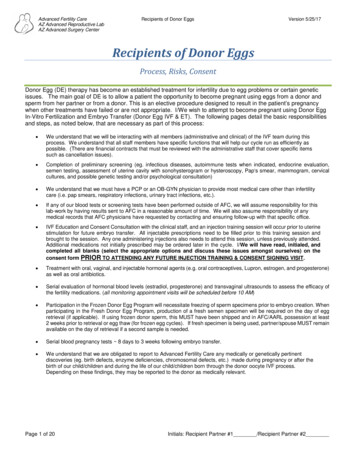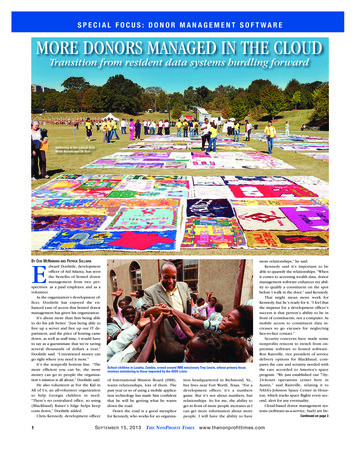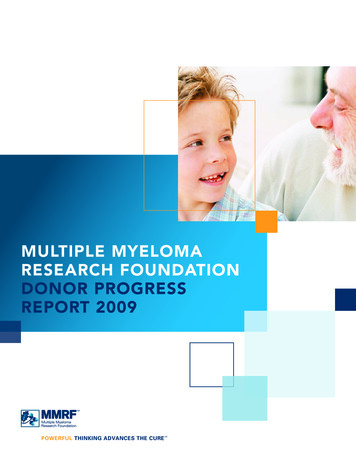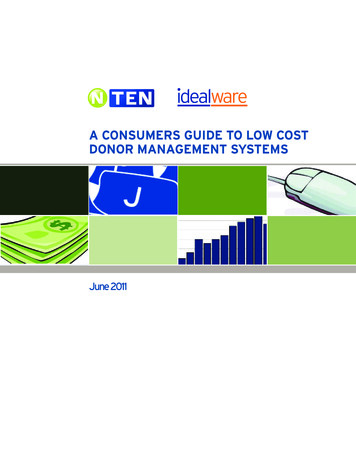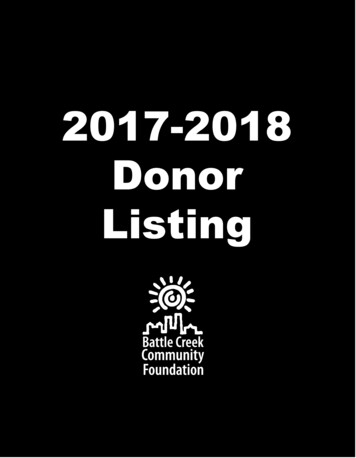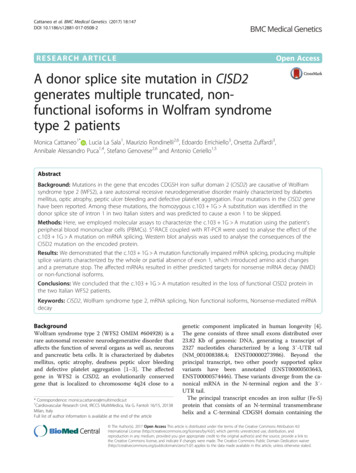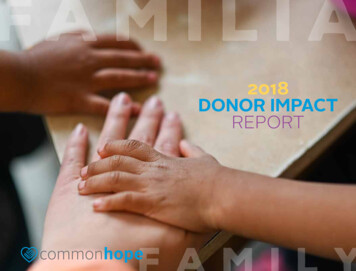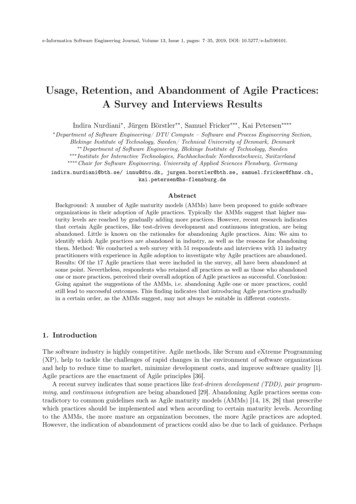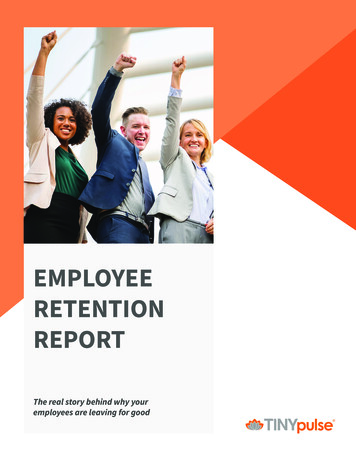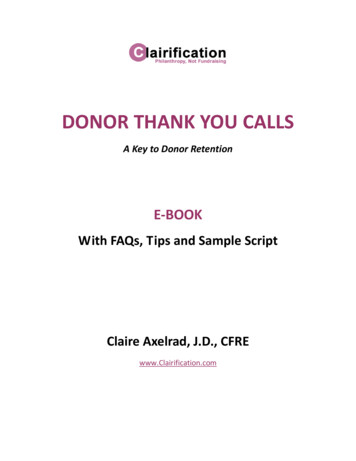
Transcription
DONOR THANK YOU CALLSA Key to Donor RetentionE-BOOKWith FAQs, Tips and Sample ScriptClaire Axelrad, J.D., CFREwww.Clairification.com
What’s Inside:8 Most Frequently Asked Questions about Thank You Calls6 Most Important Elements of a Great Thank You CallMost Important Donors to CallDonor Thank You Call Sample ScriptA Word about Thankathons: Good, Bad and UglyA Call is a Terrible Thing to Waste: What to Do After the Call2
8 Most Frequently Asked Questions about Thank You Calls1. Why should I care?It’s very simple. Donors who are called give more next time.2. Who should make the call?Whoever will be prompt, warm and genuinely grateful. Some folks recommendthat volunteers, especially board members, make these calls. I believe folks arejust as happy to receive a timely call from a staff member, as long as the callerdoesn’t sound like they’re robotically checking a task off their ‘to do’ list.3. When should I call?It’s best to do so within a month of the gift. After that it is more likely to beperceived as an additional solicitation.4. What makes a great thank you call?A smile. Seriously, with a smile on your face you’ll have a smile in your voice.People perceive this. This works for any conversation you have with donors.5. What else should I talk about on the call?Nothing. The greatest impact of this call comes from its purity. Donors arepleasantly surprised that you’ve called simply to express gratitude and that youdon’t want anything else from them.6. What else can I talk about on the call?Whatever your donor offers to talk about. As a caller, part of your job is to listenfor that offer. If they want to gush about how much they like your program, letthem. And engage them a bit with open-ended questions about what they likemost and/or what you could do to make an even greater impact.7. Should I leave a voice mail message?Absolutely! It’s silly to waste the time/energy you took to make the call. Try againone more time because research shows retention is better when you speak witha live person. Be pragmatic though. If you know you won’t have the time to tryagain within a two-day timeframe, leave a message now. Keep it short. No onewants to come home to a long, rambling voice mail.8. If I leave a message, should I leave my phone number?If you’re a staff member, yes. “If there’s ever anything I can help you with, here’smy direct number. Please don’t hesitate to call me any time. Thanks again!” Ifyou’re a volunteer, it’s really up to you. If you’re comfortable taking anunexpected call at the office or standing in line, go for it. If not, then no.3
6 Most Important Elements of a Great Thank You CallAside from the things that come up in the FAQs, here are a few things of which tobe aware (and they are incorporated into the Sample Script).1. Use the person’s name. Remember, this is a personal call. There’s a lot ofpower in calling a person by their name. It makes people immediately morereceptive, because they know they are known. And the number one thing donorscare about, according to groundbreaking research by Penelope Burk, author ofDonor-Centered Fundraising, is to be shown they are known.2. Tell them your name and connection. Your donor shouldn’t have to besuspicious of you even for an instant. Let them know who is calling .3. Immediately get the ‘thank you’ out there. We’ve all become apprehensivewhen we receive calls from phone numbers we don’t immediately recognize. If Ihad to boil down your thank you call to one sentence it would be this: “Hi Joe,this is Claire working for Beloved Charity, and I just called to say how much weappreciate your recent gift to support our Important Program!” With a smile inyour voice, that’ll do the trick. If you hem and haw too much, or have too muchintroduction, they’ll hang up on you before you get to the gratitude.4. Acknowledge the purpose of the gift. Remember, donors like to be shownthat we know them. The caller should know for what campaign or purpose the giftwas made, and should mention that. It not only makes the call more personal, italso reminds the donor of the decision they made. Donors responding toPenelope Burk’s surveys consistently say that, first and foremost, the way tokeep them is with a (1) prompt, (2) personal acknowledgment, (3) reassuringthem their gift will be used as intended. If it was in response to a challenge,acknowledge that too. Make the donor feel super good in whatever way you can.“You know, you really helped us maximize that challenge gift. We wereconcerned we wouldn’t reach our goal, but you pushed us over the top!”5. Be prepared in case the donor wants to talk. If you’re a staff member youprobably know plenty about your organization and can tell inspiring stories andquote compelling statistics to show the donor’s impact. If you’re assigning thecall to a volunteer be sure to prepare them with a Fact Sheet and a few storyvignettes showing how the donor’s gift made a positive difference. And let themknow it’s okay to say “Great question! I don’t know the answer, but I’ll find outand get back to you.”6. Be interested in your donor. If the donor is willing to talk this is a greatopportunity for direct donor research. Ask open-ended questions about thedonor’s family, interests, work, and history all the things you would asksomeone who you were just meeting, and who you hoped might become a truefriend. This is all about building relationships.4
Most Important Donors to CallWhich donors should be called?People often ask me who should be targeted to receive these calls. After all, youcan’t call everyone. Can you?The answer to this question is: It depends. If you’re a small nonprofit then callingevery single donor may be your best way to begin to build your donor base. Youneed to wow folks and impress upon them not jus how grateful you are but howefficient and on top of things you are. The more you build trust, the more you’llbuild a relationship. Then these donors will be more likely to stay with you, andyou won’t simply be churning donors in and out keeping a static mailing list.Here’s a mantra borrowed from Penelope Burk of Donor-Centered Fundraising,with my italics added:Treat every donor like a major donor when you can.Of course, it isn’t always practical to call every donor. In that case PRIORITIZE your calls in this order:MUST CALL: First-time donors. Ideally you would call every single new donorbecause this is the time when you are most vulnerable to losing folks.Penelope Burk’s research shows you’ll lose 50% of folks between the firstgift and the second appeal (If you haven’t read her book, make it be theone take-away you get from this e-book; it changed my entire practice!).The same research shows that new donors who receive a call within 48hours of making their first gift will give approximately 40% more the nextyear (and this research has been recently confirmed). Calling them canmake a huge difference! 100 first-time donors. If you can’t manage to call all new donors, calldonors of 100 . This is more than a token gift, suggesting excellentpotential for building a lasting relationship. Treat these folks like gold. Donors who increase their support. This may mean coming up with aformula so that you can generate a list from your database. For example,5
donors who give double last year’s amount donor’s who increase to thenext giving level donors who give 20% more than last year, etc. Donors who give at a specified dollar cut-off point. All leadership leveldonors should be thanked personally if you want them to stay at this level.You may want to assure that your major donors (e.g., 1,000 get a callfrom your Executive Director or Board President to show them that younoticed what a special commitment they’re making). Donors who reach a consecutive giving milestone. Loyal donors aregolden. If you don’t have a means of recognizing consecutive yeargivers, consider doing so. (e.g., some organizations have a “‘Ten’ureSociety” for folks who’ve consistently given for 10 years. When a donorreaches this milestone, call and congratulate them! These are donorswho are most likely to leave you a legacy at some future point.6
Donors who are called give more next time. Pause a minute to remindyourself how important these calls are. Penelope Burk’s research in DonorCentered Fundraising revealed those who were called subsequently gave 39%more. After 14 months, when asked again, they gave 42% more!Even though you can’t call all of your donors, selecting just a few to call eachweek can have a huge impact. Did you know that increasing donor retention by10% today can enhance the lifetime value of your donor base by 200%? Again,because these calls make such a huge impact on donor retention, they must behandled promptly. If you assign them to volunteers don’t make the assignmentan optional “do this whenever you can get to it” sort of thing.Aside from the “must call” donors discussed above, here are some tests you cantry to see if it makes sense to move other groups of supporters into your “mustcall” list next year.TESTS: Monthly and recurring donors. If you have a monthly giving programthese supporters should get at least one thank you call during the courseof the year. If you don’t, you’ll still have donors who make multiple gifts.For these folks you should establish some sort of “trigger” for making calls(e.g., whenever a donor makes their third gift within X time frame). If youdon’t have the bandwidth to call all these folks, call a subset. Then trackyour results. If the group receiving calls renews at a higher rate, or givessignificantly increased gifts, then you can roll this strategy out to a largergroup next year. Donors you’d like to upgrade to the next giving level. Let’s say youhave a lot of donors giving in the 250 - 999 range. We too often ignoreour mid-level donors, and they get stuck in the middle forever. Try callingone in five (a random sampling) and see if they renew at higher rates thanthose who did not receive calls. Donors who also engage with your organization in other ways. Adonor who also enrolls their kid in your camp program, or comes to aperformance, or buys a product or attends a workshop is more engagedwith you than someone who gives money alone. It’s worth testing to see ifa phone call might upgrade giving from these folks. Remember to showthem that you know them when you call (this is where it really helps tohave integrated databases).7
A Word about Thankathons: Good, Bad and UglyThe Good:Thankathons are another technique to incorporate planned donor thank you callsinto your acknowledgment/stewardship program. It’s a great way to involvevolunteers because, inevitably, it’s a feel-good experience for everyone involved.It’s more fun to do it as a group – with refreshments of course! And when yougather everyone together you can do some training and practice with the script.You also have the opportunity to share an inspiring “mission moment” that getsfolks revved up to make the phone calls. You can share a client story, or simplygo around the room and ask volunteers to share their own personal story aboutwhy they’re involved. Here’s what happened one time when I did that.The Bad (but not really):It’s hard to get a group together these days, and fewer places have a bank ofphones from which to call. So it’s okay to dole out names and have folks call fromtheir home or office. Leaving messages on voicemail is fine. If you get someoneon the phone most supporters are pleasantly surprised to receive a call that’spurely a thank you, and this pleasant feeling is passed along to the caller. Forvolunteers who’ve been afraid to pick up the phone to call donors requestingsupport, this is a terrific way to get their feet wet. Just make sure to arm themwith a script in advance (see below), and give them a little time to practice.The UglyDo not use thankathons as an excuse to relieve your staff (and/or assignedvolunteers) of the responsibility to make real-time calls. Prompt, personal callsare the gold standard. In my experience I’ve found that the best way to assurethis happens is to assign this responsibility to staff on an as-the-gifts-come-inbasis. That doesn’t mean you can’t also ask volunteers to make calls. Truly, it’sdifficult to thank your supporters too much.8
Donor Thank You Call Sample ScriptHOW TO USE YOUR SCRIPT:It’s just a guideline. Don’t read it. You want to be yourself. Every thank you callwill be different. Yet there are some common elements of a great thank you callthat you’ll find in the suggested sample script (the highlighted words are the onesto be sure to include).SAMPLE SCRIPT:BeginIntroduce yourself:Hi (donor’s name). This is . I'm a (staff,volunteer, alumnus, board member, etc) of (org name). I'mNOT calling to ask you for money. I'm just calling to thank you for thedonation you made to (specific project, fundraising appeal,etc.). It really means a lot and I wanted to tell you personally how gratefulwe are.Pause for a second or two. One of these things will likely happen:1. The donor will be silent, caught off guard, or confused about what to say.2. The donor will say something but won't be particularly effusive or seeminterested in chatting.3. The donor will say something appreciative about your organization or hownice it was of you to call.If it's option #1 or #2, simply:Say something particular about this gift and thank again:Okay, I don't want to take up any more of your time. I just wanted to thankyou again for (making this first gift/increasing your giving this year/yourlongtime support. Have a wonderful day/evening/week-end!If it's #3 and the donor seems open to being engaged, you can have a briefconversation about their connection to your organization, why they give, etc. Butgauge their interest level and don't overstay your welcome.If they do want to talk, then:9
Get to know the donor:I want to respect your time but if you have a moment, I would love to knowmore about what inspired you to give and the programs that interest youthe most.Listen. Converse. And please take notes (see A Call is a Terrible Thing toWaste, below).You may hear about other organizations they work with, abouttheir family background, etc. Everything you learn becomes an opportunity forfurther bonding.You can also ask open-ended questions to elicit greater response. Ask whatfeels natural to you. The key is to find the delicate balance between appearinggenuinely interested in the donor as a person (not just a wallet) and making themfeel they’re undergoing the third degree. Be brief. But don’t leave a donor whowants to chat high and dry. Here are suggestions: How did you first become interested in our organization?Tell me a little bit about why this cause matters to you.If you had to pick the program that most interest you, what would it be?Is there anything I haven’t asked that you’d like to share with me?Invite the donor to get to know you better:Would you like to be involved with us in other ways beyond being adonor?If the donor is receptive to becoming more involved, and you feel that you’vemade a real connection, you can also ask if they’d like to join you for coffee attheir convenience. Be careful with this, because you don’t want them to feel thatyou’re trying to ask them for another gift at this point.Wind up the call with a final thank you.This is also an opportunity to verify their contact information (you may have acorrect phone number, but their mailing or email address may have changed).Don’t get discouraged if most donors don’t want to chat a lot, or if youmostly end up leaving messages. The thank you calls still count!10
A Call is a Terrible Thing to Waste: What to Do After the CallMake a record.Whether you just leave a voicemail or have a live conversation with a donor, youwant to make a note of the results and record them in your database.Remember, the goal is to show donors we know them. Once they’ve told ussomething, they expect us to remember! If you assign the calls to volunteers orother staff, make sure they report back to you with the results of their calls. It’syour responsibility to make sure this information is captured so that you canbecome more and more donor-centered as you build your relationships.You may want to make yourself (or your volunteer) a cheat sheet or checklistonto which notes can be added during the call. Some things to watch for: Was the donor receptive to the call?What did you learn about why they gave, their favorite programs, etc.?What else did you learn about their interests and/or other philanthropies?What did you learn about their family and/or personal/professionalbackground?Did they offer any suggestions for improvement?Did they have any complaints?Were there any changes to their contact information.Don’t forget to code the simple fact that this donor received a call, especially ifyou’re doing a test. It’s the only way you’ll know if those who were calledperformed better than those who were not called.Do what you said you’d do, and do it NOW.This seems obvious, but sometimes there are too many cooks in the kitchen. Ifyour job is to call, but it’s someone else’s job to follow up, make sure it doesn’tget lost in the shuffle.Channel an attitude of gratitude.Your overriding mantra for the call should be to make it feel as warm, gracious,appreciative and personal as possible. In fact, that’s why I emphasize using theword “personally” in the script. This is not an automated response or a genericthank you letter. No one else is getting this call. No one else is making this call.This is between you and the donor. A little ray of sunshine. A verbal bouquet offlowers. And maybe, if you’re lucky and the donor feels a bit chatty, a little bitlonger moment of bonding around your shared values. How lovely is that?An offer you’d be crazy to refuse:Click here to set up a 15-minute appointment to chat with me about yourstewardship program, or anything else that’s keeping you awake at night. I11
encourage you to take advantage of the opportunity to send me your keyquestions in advance so we can maximize the use of our time together (use the“comments” section). It’s absolutely free. But my available time slots are limited,so claim your time now.Need more help than that? I’ve been in your shoes. I’ve tried to do everything Iknew I should be doing, but somehow couldn’t convince my leadership that it wasworth doing. I’ve wanted to hire a consultant to help me persuade plan probe prioritize persuade put into practice but couldn’t afford it and justcouldn’t figure out how to make everything happen.That’s why I’m now offering a simple and quick ‘Hour of Power.’ You’d beamazed at what we can pack into an hour, especially if you let me know a little bitabout your challenges in advance of our session. We can do coaching,brainstorming or problem solving. Your choice. Grab your ‘Hour of Power’ here.Then send me whatever you’d like us to review or discuss. I’ll review it inadvance; then we’ll spend an hour on the phone talking about ways to help yousucceed. Plus, I’ll answer any questions you have.Finally This e-book is excerpted from my new Special Guide: HOW TO CULTIVATE ANATTITUDE OF GRATITUDE AND KEEP YOUR DONORS . With 41 full pagesjam-packed with both the theory and the practice of gratitude, it has everythingyou need to persuade your leadership of the value of putting more resources intothis absolutely essential practice. Plus there are plenty of templates and scriptsso you don’t have to start everything from scratch. And there’s a great ResourceGuide and a lot of really cool creative ideas. You may want to check it out .12
wants to come home to a long, rambling voice mail. 8. If I leave a message, should I leave my phone number? If you’re a staff member, yes. . need to wow folks and impress upon them not jus how grateful you are but how efficient and on top of thin
